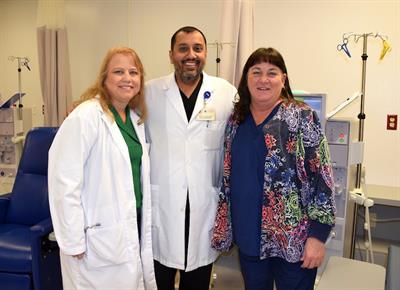
The UTMB Correctional Managed Care dialysis team works like a well-oiled machine, seamlessly treating about 46 patients at a time between the Estelle Unit in Huntsville and Carole Young Medical Facility in Dickinson. Dialysis machines run nonstop six days a week between 5 a.m. and 10 p.m. to ensure UTMB CMC’s 211 dialysis patients receive care with patient outcomes above state and national standards. The team has found success through interdisciplinary collaboration, innovative use of resources, commitment to excellence and a focus on providing Best Care.
Ten years ago, CMC Dialysis ranked below the 50th percentile among dialysis clinics in Texas, according to quality indicators. That’s when Dr. Dave Kharuna took the job as senior medical director.
“I was early in my career and felt like I could accomplish so much in a little amount of time with a big number of patients,” said Khurana, a nephrologist. “I knew I had a good team, but we had our work cut out for us.”
Not even 24 hours into his new role, the Texas Department of Health and Human Services showed up to survey the CMC dialysis program. The findings revealed numerous areas for clinical improvement. Khurana sat down with the entire dialysis department, including the nursing team, providers, social workers and dieticians, to create a corrective action plan.
“We looked at all the quality indicators—from paperwork, documentation, infection control to cleanliness—and quickly came up with an action plan that included changes to medication formulary, patient education, and better communication among medical staff and prison security, who help with efficient patient flow,” said Khurana.
When it was time for the next survey, patient outcomes had improved significantly.
“By the end of the first year, we went from below 50th percentile all the way to number one or two for all dialysis clinics in the entire state of Texas,” said Khurana,who pointed out that CMC Dialysis bounces between being the second and third largest dialysis clinic in the state. “Things were falling into place, but we asked ourselves, how can we make the program even better?”
To keep up with the needs of an aging prison population, Khurana and the dialysis team have continued to implement improvements. As the population gets older, the number needing life-saving dialysis treatment has tripled—from 69 patients in 2001 to more than 210 currently. Each of these patients is hooked up to a dialysis machine three times a week to clean and filter their blood.
With that in mind, preventive medicine has become a top priority. Modeled after “free world” dialysis clinics, Khurana has spearheaded the use of Chronic Kidney Disease clinics, or CKDs. With the help of pharmacists at UTMB CMC’s central pharmacy in Huntsville and primary care providers at prison units, offenders who show signs of declining kidney function are identified, put on medications and monitored.
“This collaboration has allowed us to prevent some people from ending up on dialysis or from going on dialysis sooner than they should,” said Khurana. “I couldn’t do it myself—but the combination of the pharmacists with the primary providers has given me an extension across the state. It has made it easier to make sure people are on the right medications and are meeting blood pressure and cholesterol goals in order to slow the progression to dialysis. It’s worked out really well by improving patient outcomes and lowering medical costs.”
CMC Dialysis has also created an End-Stage Renal Disease(ESRD) clinic to help patients have a smooth transition to dialysis. Part of that involves a partnership with the UTMB Department of Surgery in Galveston to ensure offenders who need dialysis have surgery to prepare a fistula, which connects an artery to a vein in the arm. Fistulas are considered the “gold standard” of vascular access and provide a long-lasting site through which blood can be removed and returned during dialysis.
Other innovations, such as telemedicine, have also helped the dialysis program reach more patients and improve outcomes in a cost-effective way. Khurana recalled an instance where the technology even helped save a life when he wasn’t able to see a patient face-to-face.
“I was driving on I-45 about 30 miles from the Estelle Unit, when a nurse called to have me look at something suspicious on the arm of a dialysis patient,” he said. “I pulled over and zoomed the camera in on his bicep and told the nurse to get the patient to the ER immediately—he had an abscess that was about to rupture. Fortunately, we got him there just in time and they were able to do surgery and avoid a really bad situation. Being able to prevent a prolonged hospitalization or mortality in any case is wonderful.”
Jennifer Elmore, cluster nurse manager with CMC Dialysis, said it’s been great to see dialysis care evolve into what it is today.
“To see people live longer and stay healthier is awesome,” she said. “We’ve had people on dialysis for almost 20 years—which is almost unheard of—and that’s an accomplishment that can be attributed to the excellent teamwork and improved coordination of care.”
Khurana agreed, adding that providing Best Care is always the goal for his team.
“We’ve met every goal or standard we needed to reach to be average, and then taken it to the next level,” he said. “From a correctional standpoint, we are the exception, not the norm. The majority of states outsource their dialysis programs to private for-profit vendors, but our goal is to always provide the most cost-efficient, highest quality of care. It’s a challenge we can all get behind.”